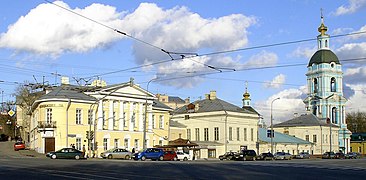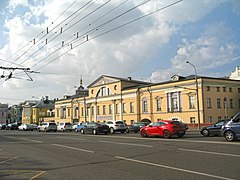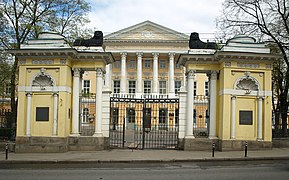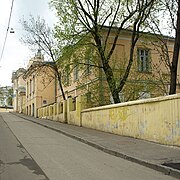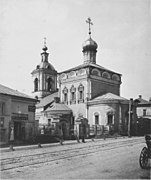Jausskaya Street

The Jausskaja Street ( Russian Яузская улица Jausskaja Ulitsa ) is a street in the district Tagansky in the Central Administrative District of Moscow . It began as a continuation of Solyanka Street and leads to Verkhnyaya Radishchevskaya Street, crossing the Jausa through the Astakhovsky Bridge. It is connected to Goncharnaya Street through Ryumin Street .
designation
The first part of the street to Jausa was named Jausskaja in the 18th century. The second section was originally called "Taganskaya" or "Tagannaya Street". In 1922 it was renamed after Internazionalnaja Street, in memory of the International Workers' Association . In 1994 this section was recognized as a continuation of the first part, and was thus also named "Jausskaya Street".
description
The Astachowski Bridge was built in 1805 and was originally called the Jausski Bridge, after which it was built over several times, most recently in 1940. It is 46 meters long and 36 meters wide. The bridge got its name in memory of the Bolshevik and revolutionary Illarion Astachow, who was shot dead by police on the bridge in 1917.
The street is built with remarkable buildings. The odd house number page includes:
- House number 1/15 - the manor house for AA Goncharov-Filippovy (Russian Городская усадьба А.А. Гончарова-Филипповых ) - a complex of buildings from different eras. The oldest building (former sailing workshop) dates back to 1718. In the 1790s, the main building was built by the architect Ivan Egotow, who was a student of Matwei Kazakow , in the classicism style on behalf of Natalia Goncharova's grandfather . At the beginning of the 19th century General Field Marshal Ivan Gudowitsch lived here for a few years , after which the merchant AM Smirnow bought it. The second floor was made of wood and was destroyed in the fire in 1812. In 1818 the house was bought by the merchant Filippov, restored by him, and served as a shop and tea factory. In 1903 the house was slightly rebuilt by the architect AW Krasilnikow. After the October Revolution, it was nationalized and converted into a residential building. A restoration followed from 2007 to 2011, which gave the house its original appearance. The neighboring building at number 1 / 15-1 was built by the businessman Smirnow for his son, professor at Moscow University, SA Smirnow, and belonged to the Smirnow family until the revolution.
- House number 5 - a residential building from the 19th century
- House number 11/6 - the Bataschow mansion (Russian Усадьба Баташёва ). Ivan Rodionowitsch Bataschow was a mine owner. In 1792 the construction of the church of Venerable Symeon Stylites behind the Jausa began on his behalf . In 1798 he bought the extensive area near the Symeon Church, where a residential palace, a landmark of Moscow Classicism, was built from 1798–1802. The construction took place under the direction of the architect MP Kiselnikow. The total area of the building complex is around 3 hectares. The palace was damaged during the fire in 1812, and Batashov spent 300,000 rubles on its restoration. In 1878 the palace was sold to the Moscow government, which opened a hospital for workers ( Jausskaya Bolnitsa ) here, renamed City Hospital No. 23 Medsantrud after the revolution .
The page with even house numbers includes:
- A park with the monument for border guards (can be seen in the first photo). The St. Nicholas Church, which was built in 1692–1706 and demolished in 1937, was located on its territory.
- Demidow-Rachmanow mansion - two-story mansion from the 18th century after restoration in the 19th century
